Obesity: Prevalence, Causes, Risk Factors and Interventions
VerifiedAdded on 2022/11/16
|7
|1827
|314
AI Summary
This study highlights the prevalence rate of obesity, the factors that result in obesity with their associated risk factors and also highlight the interventions for preventing obesity.
Contribute Materials
Your contribution can guide someone’s learning journey. Share your
documents today.

Running head: OBESITY
OBESITY
Name of the Student:
Name of the University:
Author note:
OBESITY
Name of the Student:
Name of the University:
Author note:
Secure Best Marks with AI Grader
Need help grading? Try our AI Grader for instant feedback on your assignments.
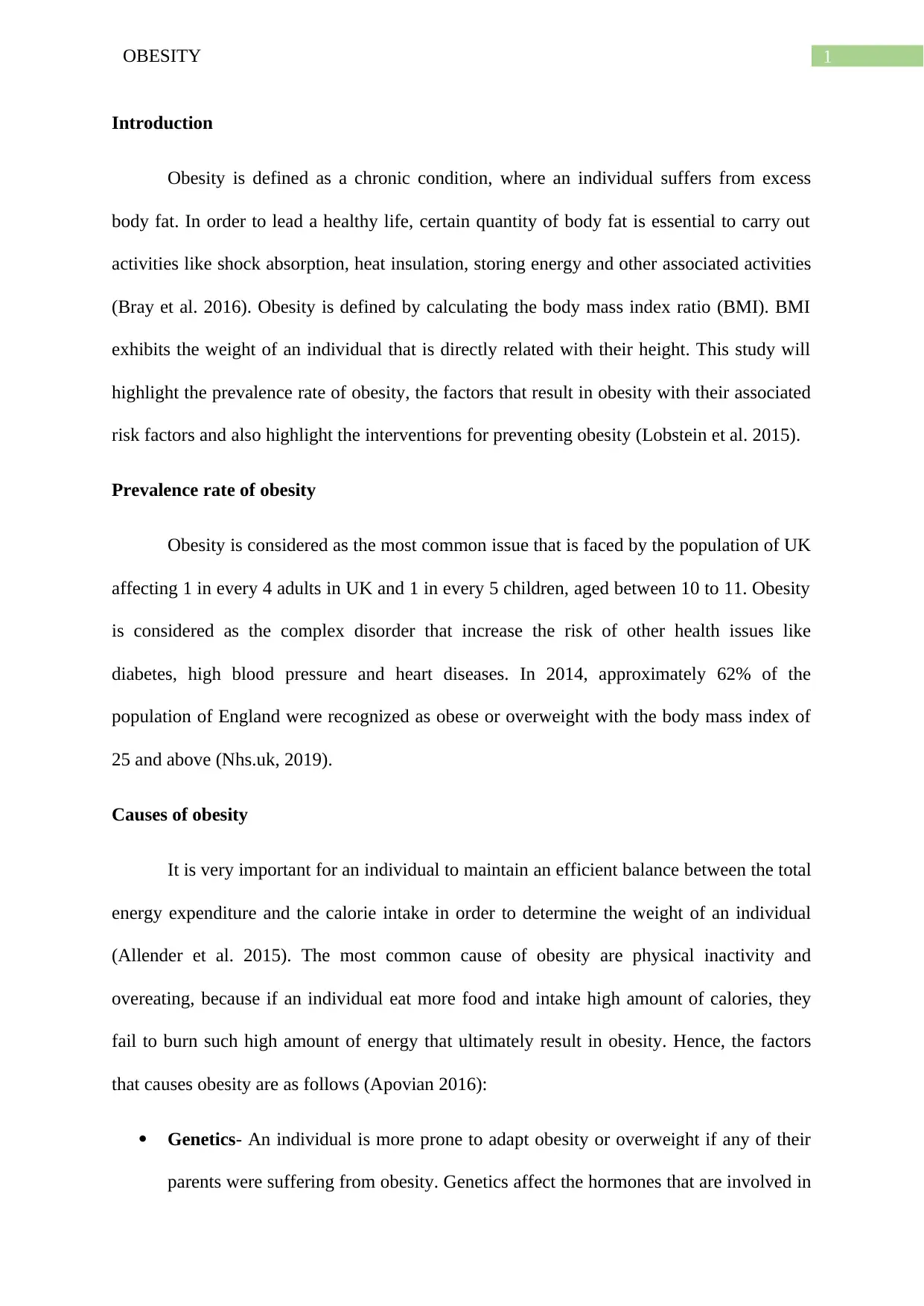
1OBESITY
Introduction
Obesity is defined as a chronic condition, where an individual suffers from excess
body fat. In order to lead a healthy life, certain quantity of body fat is essential to carry out
activities like shock absorption, heat insulation, storing energy and other associated activities
(Bray et al. 2016). Obesity is defined by calculating the body mass index ratio (BMI). BMI
exhibits the weight of an individual that is directly related with their height. This study will
highlight the prevalence rate of obesity, the factors that result in obesity with their associated
risk factors and also highlight the interventions for preventing obesity (Lobstein et al. 2015).
Prevalence rate of obesity
Obesity is considered as the most common issue that is faced by the population of UK
affecting 1 in every 4 adults in UK and 1 in every 5 children, aged between 10 to 11. Obesity
is considered as the complex disorder that increase the risk of other health issues like
diabetes, high blood pressure and heart diseases. In 2014, approximately 62% of the
population of England were recognized as obese or overweight with the body mass index of
25 and above (Nhs.uk, 2019).
Causes of obesity
It is very important for an individual to maintain an efficient balance between the total
energy expenditure and the calorie intake in order to determine the weight of an individual
(Allender et al. 2015). The most common cause of obesity are physical inactivity and
overeating, because if an individual eat more food and intake high amount of calories, they
fail to burn such high amount of energy that ultimately result in obesity. Hence, the factors
that causes obesity are as follows (Apovian 2016):
Genetics- An individual is more prone to adapt obesity or overweight if any of their
parents were suffering from obesity. Genetics affect the hormones that are involved in
Introduction
Obesity is defined as a chronic condition, where an individual suffers from excess
body fat. In order to lead a healthy life, certain quantity of body fat is essential to carry out
activities like shock absorption, heat insulation, storing energy and other associated activities
(Bray et al. 2016). Obesity is defined by calculating the body mass index ratio (BMI). BMI
exhibits the weight of an individual that is directly related with their height. This study will
highlight the prevalence rate of obesity, the factors that result in obesity with their associated
risk factors and also highlight the interventions for preventing obesity (Lobstein et al. 2015).
Prevalence rate of obesity
Obesity is considered as the most common issue that is faced by the population of UK
affecting 1 in every 4 adults in UK and 1 in every 5 children, aged between 10 to 11. Obesity
is considered as the complex disorder that increase the risk of other health issues like
diabetes, high blood pressure and heart diseases. In 2014, approximately 62% of the
population of England were recognized as obese or overweight with the body mass index of
25 and above (Nhs.uk, 2019).
Causes of obesity
It is very important for an individual to maintain an efficient balance between the total
energy expenditure and the calorie intake in order to determine the weight of an individual
(Allender et al. 2015). The most common cause of obesity are physical inactivity and
overeating, because if an individual eat more food and intake high amount of calories, they
fail to burn such high amount of energy that ultimately result in obesity. Hence, the factors
that causes obesity are as follows (Apovian 2016):
Genetics- An individual is more prone to adapt obesity or overweight if any of their
parents were suffering from obesity. Genetics affect the hormones that are involved in
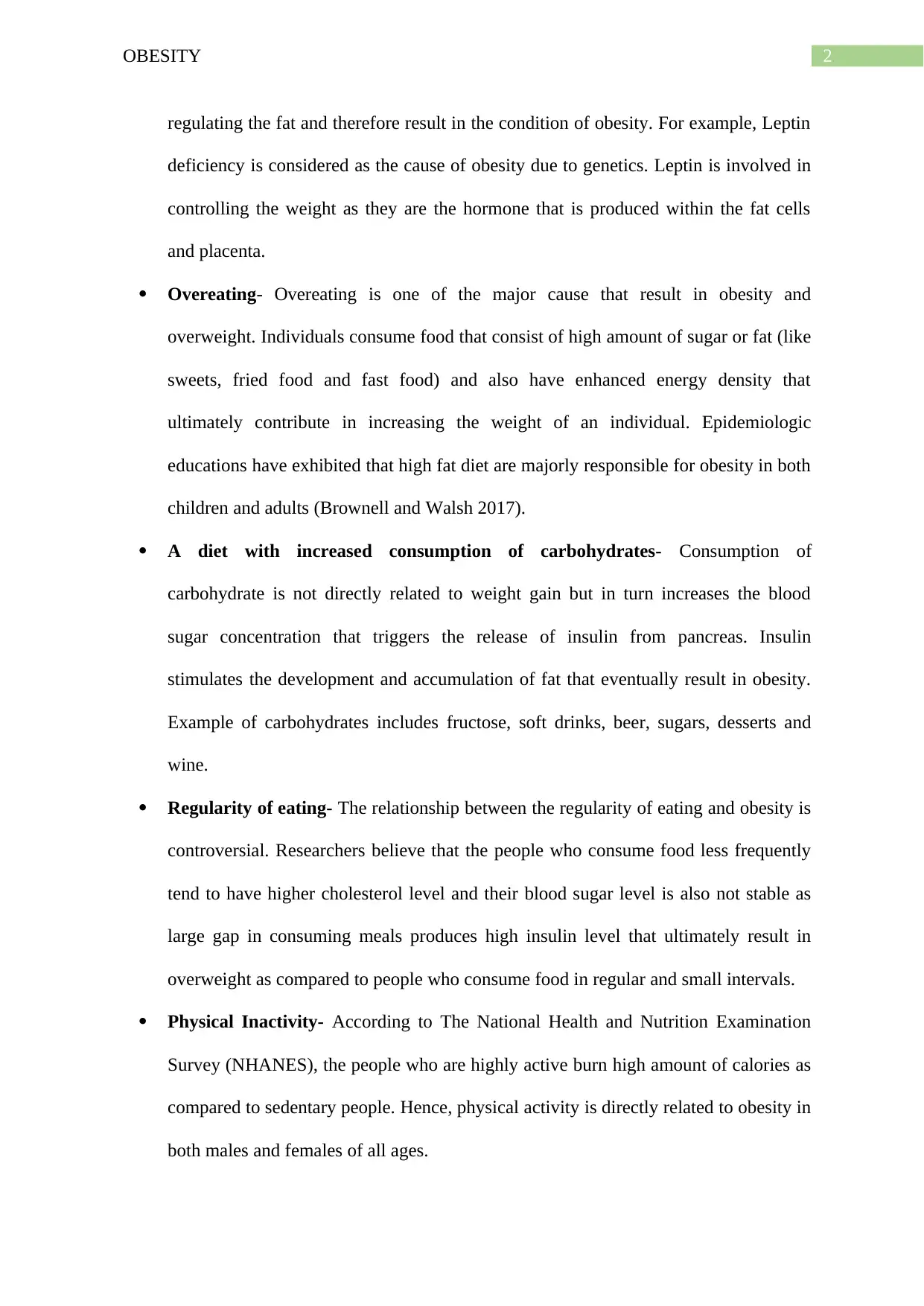
2OBESITY
regulating the fat and therefore result in the condition of obesity. For example, Leptin
deficiency is considered as the cause of obesity due to genetics. Leptin is involved in
controlling the weight as they are the hormone that is produced within the fat cells
and placenta.
Overeating- Overeating is one of the major cause that result in obesity and
overweight. Individuals consume food that consist of high amount of sugar or fat (like
sweets, fried food and fast food) and also have enhanced energy density that
ultimately contribute in increasing the weight of an individual. Epidemiologic
educations have exhibited that high fat diet are majorly responsible for obesity in both
children and adults (Brownell and Walsh 2017).
A diet with increased consumption of carbohydrates- Consumption of
carbohydrate is not directly related to weight gain but in turn increases the blood
sugar concentration that triggers the release of insulin from pancreas. Insulin
stimulates the development and accumulation of fat that eventually result in obesity.
Example of carbohydrates includes fructose, soft drinks, beer, sugars, desserts and
wine.
Regularity of eating- The relationship between the regularity of eating and obesity is
controversial. Researchers believe that the people who consume food less frequently
tend to have higher cholesterol level and their blood sugar level is also not stable as
large gap in consuming meals produces high insulin level that ultimately result in
overweight as compared to people who consume food in regular and small intervals.
Physical Inactivity- According to The National Health and Nutrition Examination
Survey (NHANES), the people who are highly active burn high amount of calories as
compared to sedentary people. Hence, physical activity is directly related to obesity in
both males and females of all ages.
regulating the fat and therefore result in the condition of obesity. For example, Leptin
deficiency is considered as the cause of obesity due to genetics. Leptin is involved in
controlling the weight as they are the hormone that is produced within the fat cells
and placenta.
Overeating- Overeating is one of the major cause that result in obesity and
overweight. Individuals consume food that consist of high amount of sugar or fat (like
sweets, fried food and fast food) and also have enhanced energy density that
ultimately contribute in increasing the weight of an individual. Epidemiologic
educations have exhibited that high fat diet are majorly responsible for obesity in both
children and adults (Brownell and Walsh 2017).
A diet with increased consumption of carbohydrates- Consumption of
carbohydrate is not directly related to weight gain but in turn increases the blood
sugar concentration that triggers the release of insulin from pancreas. Insulin
stimulates the development and accumulation of fat that eventually result in obesity.
Example of carbohydrates includes fructose, soft drinks, beer, sugars, desserts and
wine.
Regularity of eating- The relationship between the regularity of eating and obesity is
controversial. Researchers believe that the people who consume food less frequently
tend to have higher cholesterol level and their blood sugar level is also not stable as
large gap in consuming meals produces high insulin level that ultimately result in
overweight as compared to people who consume food in regular and small intervals.
Physical Inactivity- According to The National Health and Nutrition Examination
Survey (NHANES), the people who are highly active burn high amount of calories as
compared to sedentary people. Hence, physical activity is directly related to obesity in
both males and females of all ages.
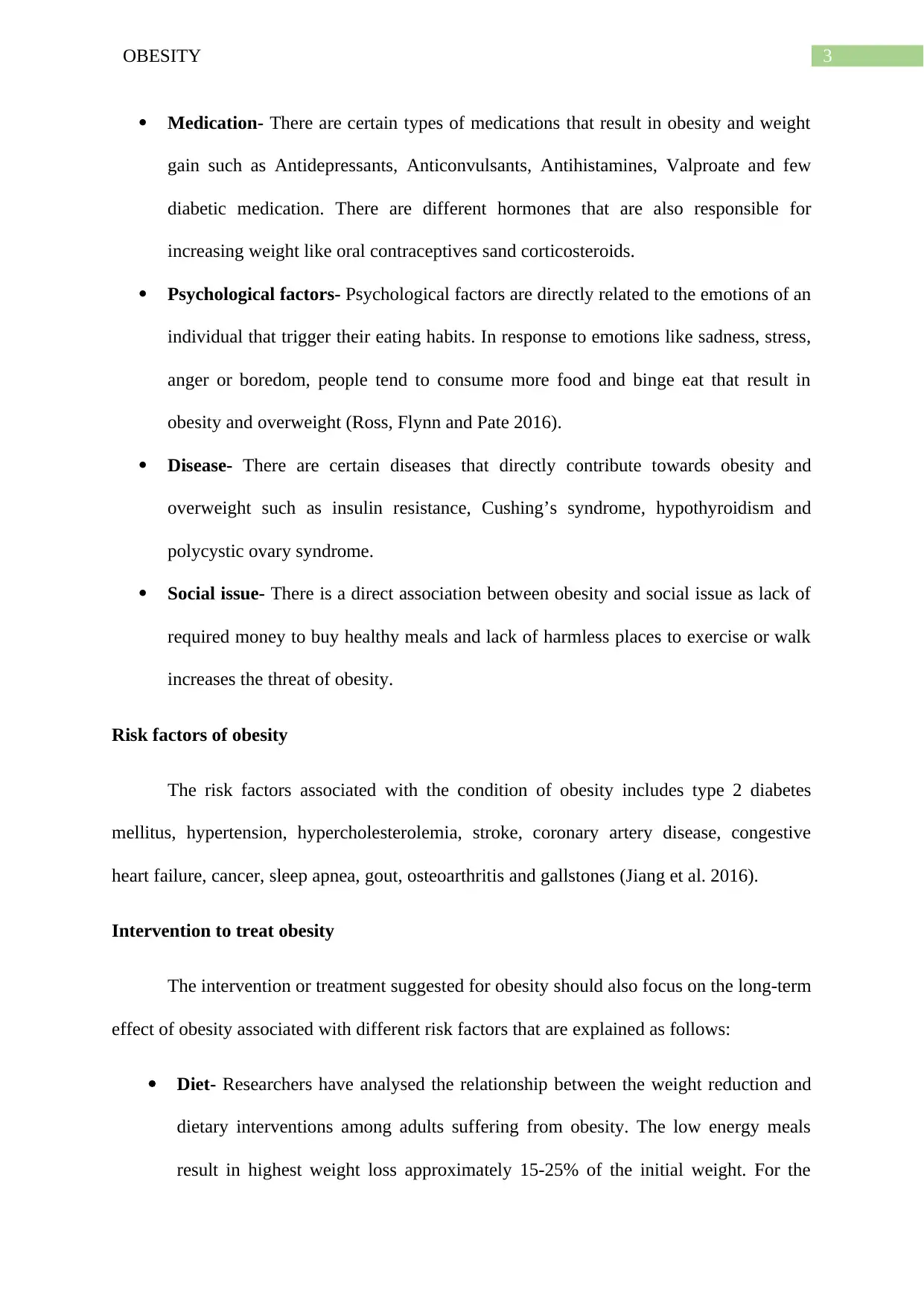
3OBESITY
Medication- There are certain types of medications that result in obesity and weight
gain such as Antidepressants, Anticonvulsants, Antihistamines, Valproate and few
diabetic medication. There are different hormones that are also responsible for
increasing weight like oral contraceptives sand corticosteroids.
Psychological factors- Psychological factors are directly related to the emotions of an
individual that trigger their eating habits. In response to emotions like sadness, stress,
anger or boredom, people tend to consume more food and binge eat that result in
obesity and overweight (Ross, Flynn and Pate 2016).
Disease- There are certain diseases that directly contribute towards obesity and
overweight such as insulin resistance, Cushing’s syndrome, hypothyroidism and
polycystic ovary syndrome.
Social issue- There is a direct association between obesity and social issue as lack of
required money to buy healthy meals and lack of harmless places to exercise or walk
increases the threat of obesity.
Risk factors of obesity
The risk factors associated with the condition of obesity includes type 2 diabetes
mellitus, hypertension, hypercholesterolemia, stroke, coronary artery disease, congestive
heart failure, cancer, sleep apnea, gout, osteoarthritis and gallstones (Jiang et al. 2016).
Intervention to treat obesity
The intervention or treatment suggested for obesity should also focus on the long-term
effect of obesity associated with different risk factors that are explained as follows:
Diet- Researchers have analysed the relationship between the weight reduction and
dietary interventions among adults suffering from obesity. The low energy meals
result in highest weight loss approximately 15-25% of the initial weight. For the
Medication- There are certain types of medications that result in obesity and weight
gain such as Antidepressants, Anticonvulsants, Antihistamines, Valproate and few
diabetic medication. There are different hormones that are also responsible for
increasing weight like oral contraceptives sand corticosteroids.
Psychological factors- Psychological factors are directly related to the emotions of an
individual that trigger their eating habits. In response to emotions like sadness, stress,
anger or boredom, people tend to consume more food and binge eat that result in
obesity and overweight (Ross, Flynn and Pate 2016).
Disease- There are certain diseases that directly contribute towards obesity and
overweight such as insulin resistance, Cushing’s syndrome, hypothyroidism and
polycystic ovary syndrome.
Social issue- There is a direct association between obesity and social issue as lack of
required money to buy healthy meals and lack of harmless places to exercise or walk
increases the threat of obesity.
Risk factors of obesity
The risk factors associated with the condition of obesity includes type 2 diabetes
mellitus, hypertension, hypercholesterolemia, stroke, coronary artery disease, congestive
heart failure, cancer, sleep apnea, gout, osteoarthritis and gallstones (Jiang et al. 2016).
Intervention to treat obesity
The intervention or treatment suggested for obesity should also focus on the long-term
effect of obesity associated with different risk factors that are explained as follows:
Diet- Researchers have analysed the relationship between the weight reduction and
dietary interventions among adults suffering from obesity. The low energy meals
result in highest weight loss approximately 15-25% of the initial weight. For the
Secure Best Marks with AI Grader
Need help grading? Try our AI Grader for instant feedback on your assignments.
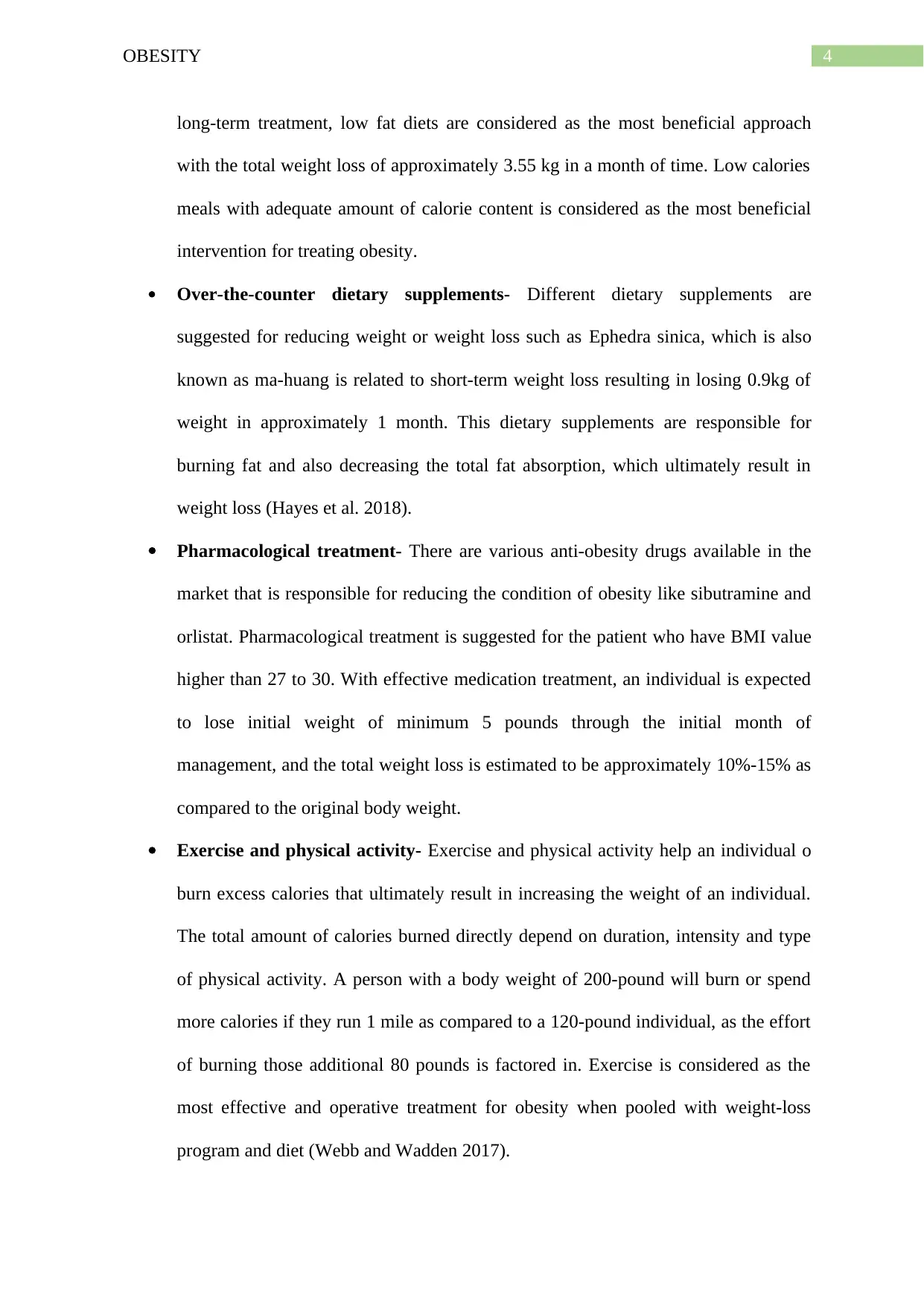
4OBESITY
long-term treatment, low fat diets are considered as the most beneficial approach
with the total weight loss of approximately 3.55 kg in a month of time. Low calories
meals with adequate amount of calorie content is considered as the most beneficial
intervention for treating obesity.
Over-the-counter dietary supplements- Different dietary supplements are
suggested for reducing weight or weight loss such as Ephedra sinica, which is also
known as ma-huang is related to short-term weight loss resulting in losing 0.9kg of
weight in approximately 1 month. This dietary supplements are responsible for
burning fat and also decreasing the total fat absorption, which ultimately result in
weight loss (Hayes et al. 2018).
Pharmacological treatment- There are various anti-obesity drugs available in the
market that is responsible for reducing the condition of obesity like sibutramine and
orlistat. Pharmacological treatment is suggested for the patient who have BMI value
higher than 27 to 30. With effective medication treatment, an individual is expected
to lose initial weight of minimum 5 pounds through the initial month of
management, and the total weight loss is estimated to be approximately 10%-15% as
compared to the original body weight.
Exercise and physical activity- Exercise and physical activity help an individual o
burn excess calories that ultimately result in increasing the weight of an individual.
The total amount of calories burned directly depend on duration, intensity and type
of physical activity. A person with a body weight of 200-pound will burn or spend
more calories if they run 1 mile as compared to a 120-pound individual, as the effort
of burning those additional 80 pounds is factored in. Exercise is considered as the
most effective and operative treatment for obesity when pooled with weight-loss
program and diet (Webb and Wadden 2017).
long-term treatment, low fat diets are considered as the most beneficial approach
with the total weight loss of approximately 3.55 kg in a month of time. Low calories
meals with adequate amount of calorie content is considered as the most beneficial
intervention for treating obesity.
Over-the-counter dietary supplements- Different dietary supplements are
suggested for reducing weight or weight loss such as Ephedra sinica, which is also
known as ma-huang is related to short-term weight loss resulting in losing 0.9kg of
weight in approximately 1 month. This dietary supplements are responsible for
burning fat and also decreasing the total fat absorption, which ultimately result in
weight loss (Hayes et al. 2018).
Pharmacological treatment- There are various anti-obesity drugs available in the
market that is responsible for reducing the condition of obesity like sibutramine and
orlistat. Pharmacological treatment is suggested for the patient who have BMI value
higher than 27 to 30. With effective medication treatment, an individual is expected
to lose initial weight of minimum 5 pounds through the initial month of
management, and the total weight loss is estimated to be approximately 10%-15% as
compared to the original body weight.
Exercise and physical activity- Exercise and physical activity help an individual o
burn excess calories that ultimately result in increasing the weight of an individual.
The total amount of calories burned directly depend on duration, intensity and type
of physical activity. A person with a body weight of 200-pound will burn or spend
more calories if they run 1 mile as compared to a 120-pound individual, as the effort
of burning those additional 80 pounds is factored in. Exercise is considered as the
most effective and operative treatment for obesity when pooled with weight-loss
program and diet (Webb and Wadden 2017).
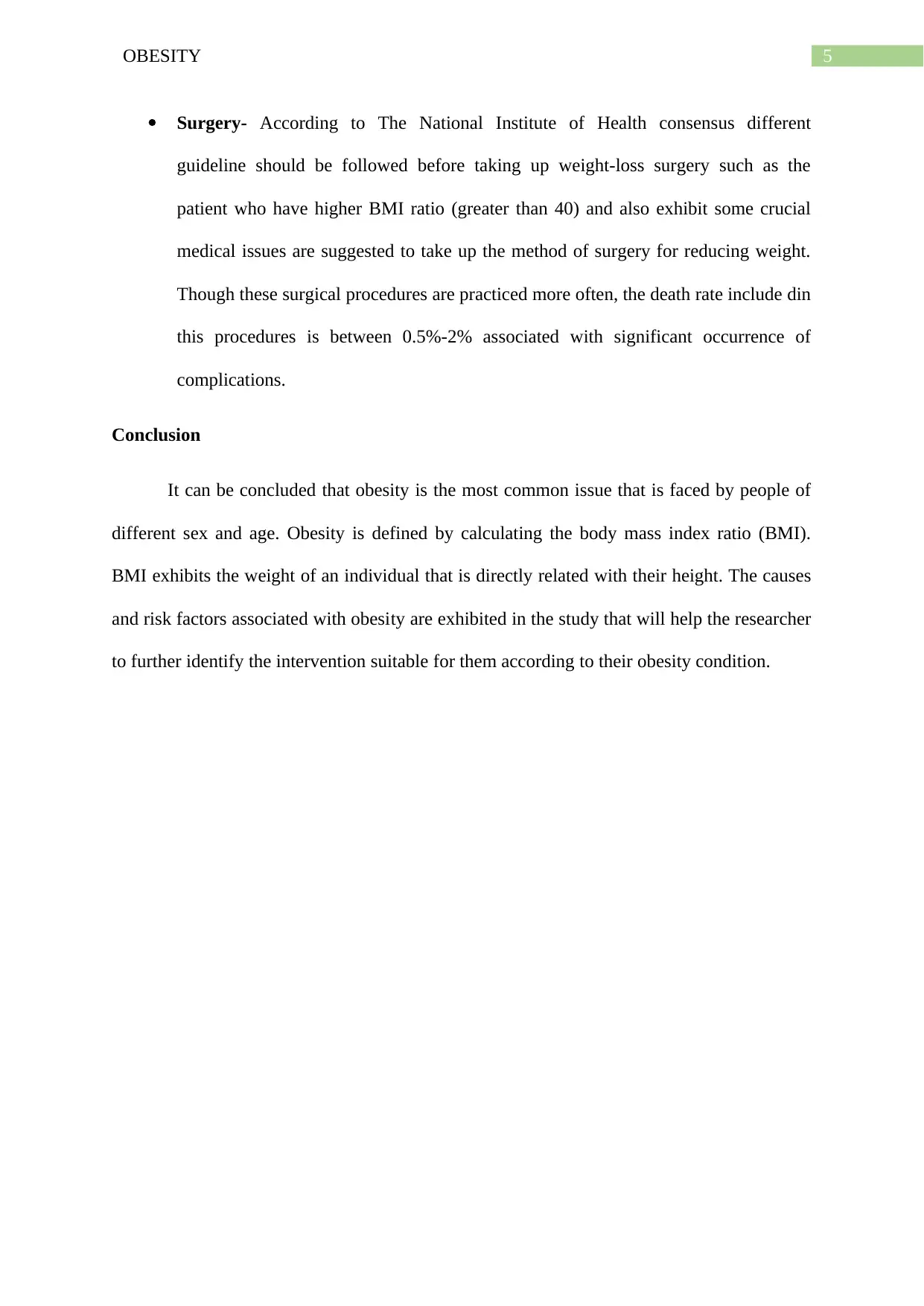
5OBESITY
Surgery- According to The National Institute of Health consensus different
guideline should be followed before taking up weight-loss surgery such as the
patient who have higher BMI ratio (greater than 40) and also exhibit some crucial
medical issues are suggested to take up the method of surgery for reducing weight.
Though these surgical procedures are practiced more often, the death rate include din
this procedures is between 0.5%-2% associated with significant occurrence of
complications.
Conclusion
It can be concluded that obesity is the most common issue that is faced by people of
different sex and age. Obesity is defined by calculating the body mass index ratio (BMI).
BMI exhibits the weight of an individual that is directly related with their height. The causes
and risk factors associated with obesity are exhibited in the study that will help the researcher
to further identify the intervention suitable for them according to their obesity condition.
Surgery- According to The National Institute of Health consensus different
guideline should be followed before taking up weight-loss surgery such as the
patient who have higher BMI ratio (greater than 40) and also exhibit some crucial
medical issues are suggested to take up the method of surgery for reducing weight.
Though these surgical procedures are practiced more often, the death rate include din
this procedures is between 0.5%-2% associated with significant occurrence of
complications.
Conclusion
It can be concluded that obesity is the most common issue that is faced by people of
different sex and age. Obesity is defined by calculating the body mass index ratio (BMI).
BMI exhibits the weight of an individual that is directly related with their height. The causes
and risk factors associated with obesity are exhibited in the study that will help the researcher
to further identify the intervention suitable for them according to their obesity condition.
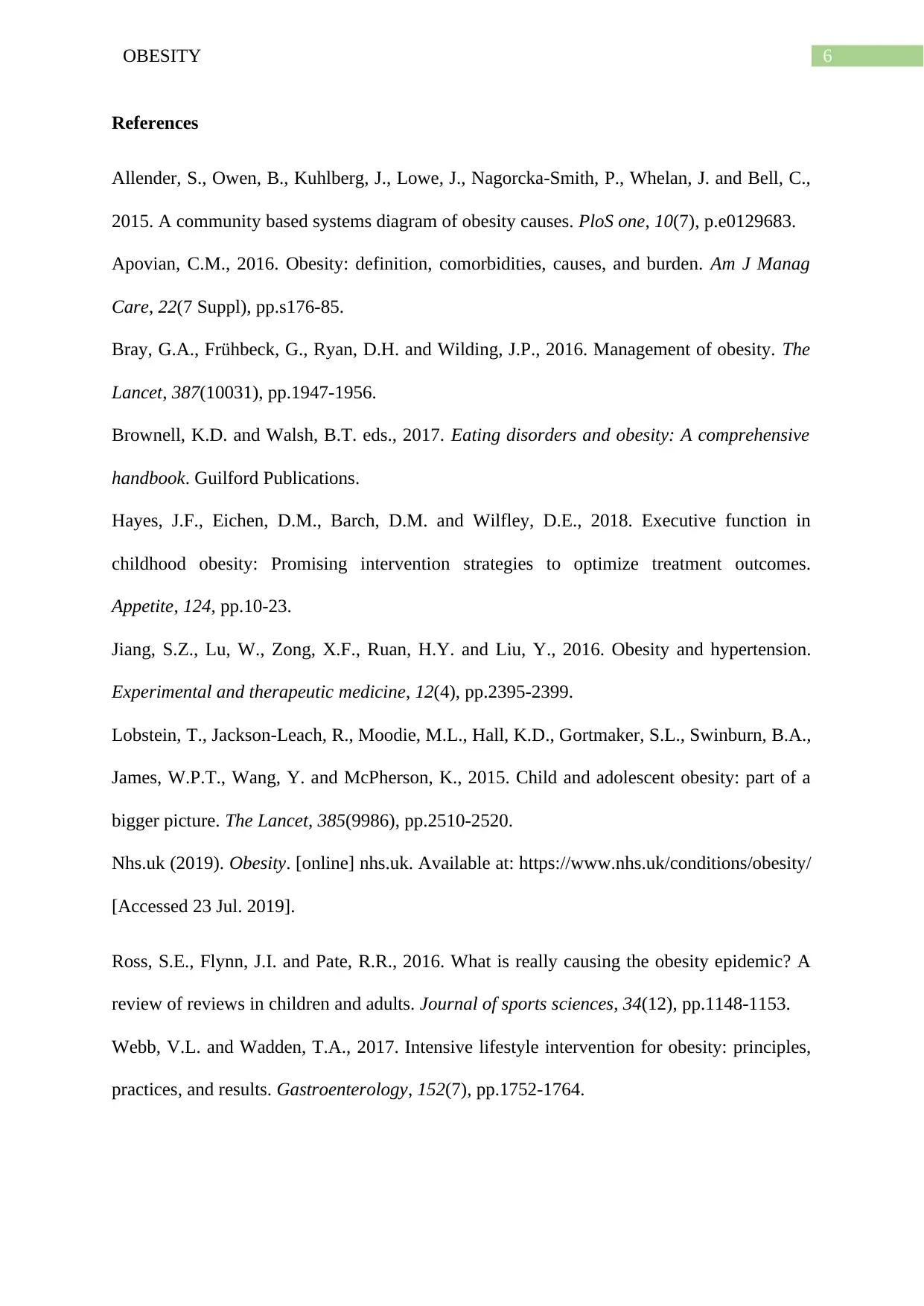
6OBESITY
References
Allender, S., Owen, B., Kuhlberg, J., Lowe, J., Nagorcka-Smith, P., Whelan, J. and Bell, C.,
2015. A community based systems diagram of obesity causes. PloS one, 10(7), p.e0129683.
Apovian, C.M., 2016. Obesity: definition, comorbidities, causes, and burden. Am J Manag
Care, 22(7 Suppl), pp.s176-85.
Bray, G.A., Frühbeck, G., Ryan, D.H. and Wilding, J.P., 2016. Management of obesity. The
Lancet, 387(10031), pp.1947-1956.
Brownell, K.D. and Walsh, B.T. eds., 2017. Eating disorders and obesity: A comprehensive
handbook. Guilford Publications.
Hayes, J.F., Eichen, D.M., Barch, D.M. and Wilfley, D.E., 2018. Executive function in
childhood obesity: Promising intervention strategies to optimize treatment outcomes.
Appetite, 124, pp.10-23.
Jiang, S.Z., Lu, W., Zong, X.F., Ruan, H.Y. and Liu, Y., 2016. Obesity and hypertension.
Experimental and therapeutic medicine, 12(4), pp.2395-2399.
Lobstein, T., Jackson-Leach, R., Moodie, M.L., Hall, K.D., Gortmaker, S.L., Swinburn, B.A.,
James, W.P.T., Wang, Y. and McPherson, K., 2015. Child and adolescent obesity: part of a
bigger picture. The Lancet, 385(9986), pp.2510-2520.
Nhs.uk (2019). Obesity. [online] nhs.uk. Available at: https://www.nhs.uk/conditions/obesity/
[Accessed 23 Jul. 2019].
Ross, S.E., Flynn, J.I. and Pate, R.R., 2016. What is really causing the obesity epidemic? A
review of reviews in children and adults. Journal of sports sciences, 34(12), pp.1148-1153.
Webb, V.L. and Wadden, T.A., 2017. Intensive lifestyle intervention for obesity: principles,
practices, and results. Gastroenterology, 152(7), pp.1752-1764.
References
Allender, S., Owen, B., Kuhlberg, J., Lowe, J., Nagorcka-Smith, P., Whelan, J. and Bell, C.,
2015. A community based systems diagram of obesity causes. PloS one, 10(7), p.e0129683.
Apovian, C.M., 2016. Obesity: definition, comorbidities, causes, and burden. Am J Manag
Care, 22(7 Suppl), pp.s176-85.
Bray, G.A., Frühbeck, G., Ryan, D.H. and Wilding, J.P., 2016. Management of obesity. The
Lancet, 387(10031), pp.1947-1956.
Brownell, K.D. and Walsh, B.T. eds., 2017. Eating disorders and obesity: A comprehensive
handbook. Guilford Publications.
Hayes, J.F., Eichen, D.M., Barch, D.M. and Wilfley, D.E., 2018. Executive function in
childhood obesity: Promising intervention strategies to optimize treatment outcomes.
Appetite, 124, pp.10-23.
Jiang, S.Z., Lu, W., Zong, X.F., Ruan, H.Y. and Liu, Y., 2016. Obesity and hypertension.
Experimental and therapeutic medicine, 12(4), pp.2395-2399.
Lobstein, T., Jackson-Leach, R., Moodie, M.L., Hall, K.D., Gortmaker, S.L., Swinburn, B.A.,
James, W.P.T., Wang, Y. and McPherson, K., 2015. Child and adolescent obesity: part of a
bigger picture. The Lancet, 385(9986), pp.2510-2520.
Nhs.uk (2019). Obesity. [online] nhs.uk. Available at: https://www.nhs.uk/conditions/obesity/
[Accessed 23 Jul. 2019].
Ross, S.E., Flynn, J.I. and Pate, R.R., 2016. What is really causing the obesity epidemic? A
review of reviews in children and adults. Journal of sports sciences, 34(12), pp.1148-1153.
Webb, V.L. and Wadden, T.A., 2017. Intensive lifestyle intervention for obesity: principles,
practices, and results. Gastroenterology, 152(7), pp.1752-1764.
1 out of 7
Related Documents
Your All-in-One AI-Powered Toolkit for Academic Success.
+13062052269
info@desklib.com
Available 24*7 on WhatsApp / Email
![[object Object]](/_next/static/media/star-bottom.7253800d.svg)
Unlock your academic potential
© 2024 | Zucol Services PVT LTD | All rights reserved.





